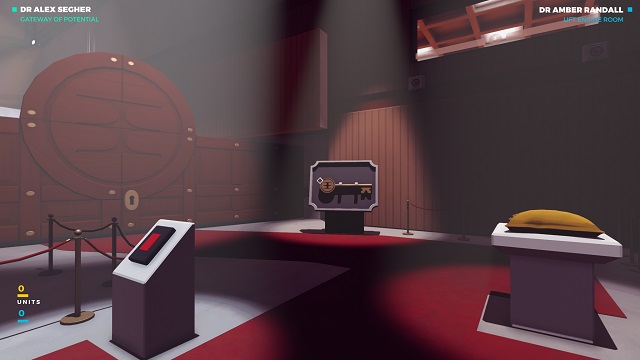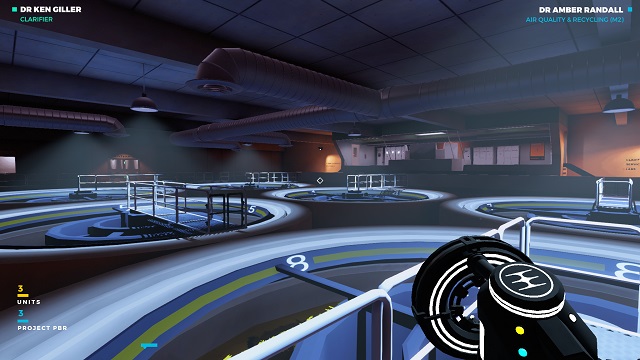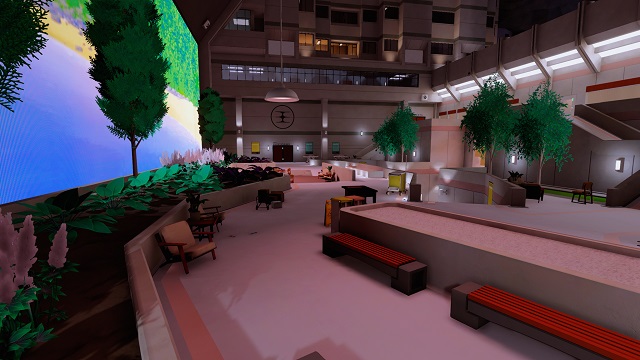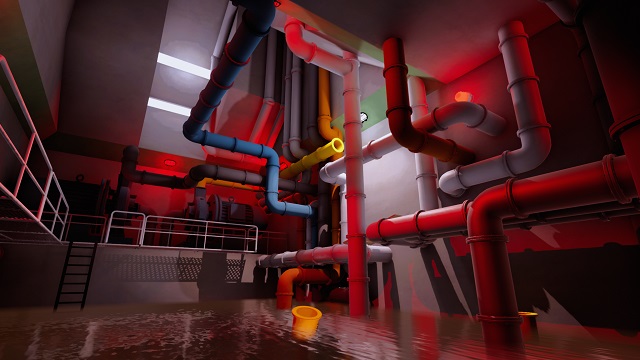There’s nothing more tantalizing than a game with potential. Be it a unique mechanic, a novel setting or an innovative twist on familiar tropes, originality can sell players on new worlds and unproven concepts. Originality can also cause problems in production. A unique mechanic can lead to design headaches. Untested locales can quickly become stale and tiresome. Sometimes, tropes are tropes for a reason. Despite a promising start, I left THE BRADWELL CONSPIRACY thinking about the murky swamp between a standard AAA blockbuster and an indie darling. While not without its high points, there’s not enough intrigue for this Conspiracy to gain traction.
The Bradwell Conspiracy Review | Talking out your problems

Perhaps part of the blame can go towards Bradwell‘s pair of interesting yet unrealized mechanics. The first, the conversations you have with your mostly-unseen partner Amber, is the more successful of the two. Finding each individual line and discovering just how much Amber could talk about certain objects was almost always a highlight. The problem comes in just how unhelpful she ended up being in actually assisting me when I got down to puzzling.
More often than not, the photos I took when stuck elicited either confused grumbles or a stark refresher on the main objective. There are no gradual hints towards the one set-in-stone solution, just a mission objective and some toys to throw at it. Dialogue also often plays out of order, referencing mission objectives I hadn’t received yet or events that occurred minutes before. It’s difficult to be too harsh since there’s a lot of dialogue here and plenty of it comes off as natural. However, that level of quality makes the questionable parts stick out and is all the more frustrating.
The Bradwell Conspiracy Review | Consistent spooler issues

The second big mechanic, a 3D printer that fills the role of advanced puzzle-solving science dohickey, stumbles more often. In theory, your 3D printer gun can absorb objects, crunch them into matter, and then recreate perfect copies elsewhere. In practice, the tool was quite limiting, both in what objects you can utilize and where you can place them. A Brave Plan probably didn’t want to give players too many options, as that would make puzzle-solving a headache. However, you can’t truly experiment at all with how you reconstitute your puzzle pieces. Again, there’s one solution, and you just have to figure it out, slotting objects into very specific spaces.
For example, at several points during my adventure, I had access to a wooden plank. This object typically comes in handy if you need to build a bridge over water or a large gap. When I saw an objective over a gap, I naturally pulled out the planks and started building, only to discover a slight height difference that makes the process impossible. After circling the area a few times, I found the one gap in the wall where I could safely build a bridge. There’s no indicator on where you can or can’t build, and no in-universe reason why certain buildings won’t work. You can’t even slant objects at an angle to make a ramp up to a second story. Everything is tight and controlled and that makes that mechanic rather dry.
The Bradwell Conspiracy Review | Too many board meetings

The Bradwell Conspiracy‘s story and writing is its strongest aspect in the early stages. The naturalistic dialogue with Amber is rather impressive, but the overall narrative doesn’t go anywhere. The word “Conspiracy” in the title gives away a bit too much, and you’ll see the tropes coming as you get the breadcrumbs in each level. There’s an evil corporate overlord, world-changing technology is threatening society, and it’s your job to blow it all up. There is at least one interesting twist in the second half, seemingly setting up an endgame decision that never appears. All that and a straight-to-VHS style cut to credits out of nowhere tells you all you need to know.
And this story has other characters as well, which was surprising to find out later on in the campaign. Having played so many first-person puzzlers, it seems standard at this point that your only interactions come from robots or A.I. constructs. Then again, after getting a good look at these models, why they kept to the background for most of the game. Much like the mistimed dialogue and the limited scope of the printer, these human faces betray that The Bradwell Conspiracy had a much grander vision than what ended up in the final product.
The Bradwell Conspiracy Review | Facing your problems head-on

This final product’s quality changes depending on where you play it as I played both the PC and Xbox One versions and finished it on console, which was a decision I soon regretted. While the Steam version runs as expected, the console version appears to be decidedly unstable. Even on my Xbox One X (Bradwell Conspiracy lacks any X enhancement), I encountered frame rate hitches and slowdown pretty consistently. Considering the rather stark art style, it was surprising just how pervasive the issues were. Hopefully, there is an update in the works that remedies these technical problems.
I also endured an unusual issue where my character would constantly shift to the side every other time I stopped moving. At first, I thought this was an attempted simulation of a constant earthquake. In the end, its consistency made me reconsider it as a glitch rather than anything intentional. I even tried several controllers to confirm that it wasn’t my hardware, and the problem remained. If you have a choice, PC is the way to go.
It’s difficult to fault a game for dreaming big, and it’s still enjoyable to hunt for secrets under Stonehenge. However, that might be because these types of forward-thinking gameplay ideas are almost always alluring. We need to see games with a sense of humanity in its characters and games that can teach the socially awkward in the same way that action games teach reflexes. Perhaps that’s too much to put on a small scale first-person experience. And perhaps it is not, but given how The Bradwell Conspiracy executed its ideas, it might actually be too much to ask for in this case.
GameRevolution reviewed The Bradwell Conspiracy on Xbox One X with additional testing on PC with codes provided by the publisher.
-
Cohesive graphical style that fits the world.
-
Interesting and natural sounding dialogue from Amber.
-
Plenty of ambitious gameplay ideas.
-
Shallow follow through on those ideas.
-
Console versions have technical issues.
-
Puzzles are too restrictive.











